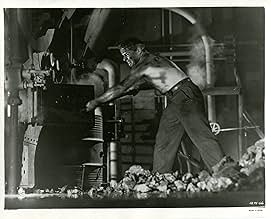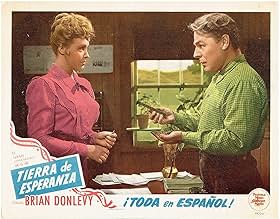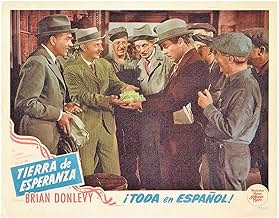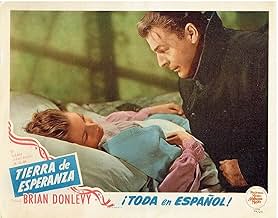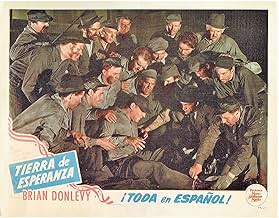VALUTAZIONE IMDb
6,7/10
640
LA TUA VALUTAZIONE
Aggiungi una trama nella tua linguaStefan Dangos, an immigrant, starts working in iron mines and steel mills. Through hard work, he rises through the ranks, eventually becoming a successful American industrialist.Stefan Dangos, an immigrant, starts working in iron mines and steel mills. Through hard work, he rises through the ranks, eventually becoming a successful American industrialist.Stefan Dangos, an immigrant, starts working in iron mines and steel mills. Through hard work, he rises through the ranks, eventually becoming a successful American industrialist.
- Regia
- Sceneggiatura
- Star
- Premi
- 2 vittorie totali
Stephen McNally
- Teddy Roosevelt Dangos
- (as Horace McNally)
- …
Ernie Adams
- Man and Dog Act
- (non citato nei titoli originali)
Erville Alderson
- Olson - Detroit Auto Works Technician
- (non citato nei titoli originali)
Fred Aldrich
- Assembly Line Worker
- (non citato nei titoli originali)
Axel Anderson
- Immigrant
- (non citato nei titoli originali)
King Baggot
- Graduation Ceremony Attendee
- (non citato nei titoli originali)
Charles Bates
- Teddy Roosevelt Dangos - Age 8
- (non citato nei titoli originali)
Barbara Bedford
- Hospitable Farm Woman
- (non citato nei titoli originali)
Arthur Belasco
- Drowsy Miner
- (non citato nei titoli originali)
Leon Belasco
- Cigar Store Proprietor
- (non citato nei titoli originali)
Art Berry Sr.
- Customs Man
- (non citato nei titoli originali)
Anna Marie Biggs
- Girl Soprano
- (non citato nei titoli originali)
Recensioni in evidenza
I saw this movie as a nine year old child and never forgot it. Later it appeared on television and more recently on TCM. I was impressed by the hero's fortitude in walking to Minnesota to join his cousin at the Mesabe Iron Range, his hard work, and his learning to read and eventually marrying the teacher. Each of his male children was named for a president after a friend remarked their child might reach that office. The movie taught me how iron ore was shipped east and processed into steel. Dangos also moves east and becomes a foreman. He eventually becomes an automobile manufacturer and his new ideas bring him success. His children succeed by achieving through the benefits of education. The movie ends after a documentary of American industry's contribution to the war effort. The Technicolor was gorgeous and Donlevy's performance believable. I still enjoy watching this film and believe King Vidor put his heart into it.
Brian Donlevy stars as an immigrant who comes to America in the late 19th century and rises through hard work to become a success.
This film was written, produced, and directed by the great King Vidor at MGM and was meant to be an American industrial epic culminating in a WW II propaganda piece with bombers flying in formation. It was also supposed to be the story of an immigrant and his family. The film was screened at 150 minutes, and Louis B. Mayer demanded the film cut down to 120 minutes. Vidor has no part in the edit, so what remains is a choppy story with lots of documentary-like scenes of industry. Most of the family story got deleted.
Initially set up at MGM to star Spencer Tracy, Ingrid Bergman, and Joseph Cotten, by the time Vidor was ready to film, Mayer balked at the cost and proceeded with a B cast of Brian Donlevy, Ann Richards, and Walter Abel. John Qualen and Stephen McNally are the only other name actors in the cast.
Saddled with a B cast, Vidor still tried to make the film he envisioned, but there are far too many cost-saving things going on, especially the cheesy sets. While there are some location shots, these are pretty much confined to industrial scenes.
The real pity is that Donlevy gives a terrific performance as does Abel in a much-reduced part. Australian-born Richards, however, is pretty bad, and her accent seems to change in every scene. With the family stuff omitted by Mayer, the narrative is choppy and the "heart" of the film is gone.
It's no surprise that after this bowdlerized version was released in 1944, it was a major flop. MGM lost a bundle and Vidor never worked for the studio again.
This film was written, produced, and directed by the great King Vidor at MGM and was meant to be an American industrial epic culminating in a WW II propaganda piece with bombers flying in formation. It was also supposed to be the story of an immigrant and his family. The film was screened at 150 minutes, and Louis B. Mayer demanded the film cut down to 120 minutes. Vidor has no part in the edit, so what remains is a choppy story with lots of documentary-like scenes of industry. Most of the family story got deleted.
Initially set up at MGM to star Spencer Tracy, Ingrid Bergman, and Joseph Cotten, by the time Vidor was ready to film, Mayer balked at the cost and proceeded with a B cast of Brian Donlevy, Ann Richards, and Walter Abel. John Qualen and Stephen McNally are the only other name actors in the cast.
Saddled with a B cast, Vidor still tried to make the film he envisioned, but there are far too many cost-saving things going on, especially the cheesy sets. While there are some location shots, these are pretty much confined to industrial scenes.
The real pity is that Donlevy gives a terrific performance as does Abel in a much-reduced part. Australian-born Richards, however, is pretty bad, and her accent seems to change in every scene. With the family stuff omitted by Mayer, the narrative is choppy and the "heart" of the film is gone.
It's no surprise that after this bowdlerized version was released in 1944, it was a major flop. MGM lost a bundle and Vidor never worked for the studio again.
"An American Romance" is the sort of film that was the perfect film for the perfect time. It is chock full of unabashed patriotism and is a bit schmaltzy--all in the midst of WWII. So, this sort of gung-ho worked well then but probably would be seen by many today as dated. However, I think that compared to many such films of the era, this one actually holds up well and is worth seeing today, as there is excellent acting and a bit of a history lesson here we could enjoy.
The film begins with Stefan Dubechek aka Steve Dangos (Brian Donlevy) arriving in America. He knows no English but like any good citizen, has a strong desire to work hard and make something of himself. So, starting off at the bottom at a steel mill, he is able to work his way up through the company. Eventually, he and a new friend find they have a great idea for a new car--and soon leave to start a company of their own.
The film is basically the American success story. Of course not every guy with vision and drive makes it--but this film seems to indicate that such an individual will. And, it also stresses the importance of such a strong-minded and committed person to the new war effort, as the film ends with Dangos organizing his factory for the mass production of aircraft.
While this could have been a dry documentary-type film, little bits of humanity and charm make this film work well. Well worth seeing.
By the way, if you do watch, pay attention to Donlevy's accent. Especially towards the end, he forgot it in a scene or two and in the next he's speaking with this strong accent once again!
The film begins with Stefan Dubechek aka Steve Dangos (Brian Donlevy) arriving in America. He knows no English but like any good citizen, has a strong desire to work hard and make something of himself. So, starting off at the bottom at a steel mill, he is able to work his way up through the company. Eventually, he and a new friend find they have a great idea for a new car--and soon leave to start a company of their own.
The film is basically the American success story. Of course not every guy with vision and drive makes it--but this film seems to indicate that such an individual will. And, it also stresses the importance of such a strong-minded and committed person to the new war effort, as the film ends with Dangos organizing his factory for the mass production of aircraft.
While this could have been a dry documentary-type film, little bits of humanity and charm make this film work well. Well worth seeing.
By the way, if you do watch, pay attention to Donlevy's accent. Especially towards the end, he forgot it in a scene or two and in the next he's speaking with this strong accent once again!
As A career merchant seaman on the Great Lake's ore carriers, and working for a large steel maker, I found this movie most interesting and well done. This motion picture contains many historical shots of early lake vessels at the locks in Sault Ste. Marie and docking in Gary, Indiana. The story seems to be based on the life of Andrew Carnegie who was also an immigrant from Scotland. My family came from the Pittsburgh area and were employed with a large steel company, so I can relate well to the plot. Brian Donlevey visited aboard some of our vessels while making this movie in the port of Gary, Indiana. I liked this movie and watch it when I find it advertised to be shown on TV. I would own it if I could buy it because of its historical value..
First take note of the date of this movie ( the forties) because we still had the mindset to be grateful and that was a time where people all over the world wanted to immigrate here. Not knowing what to expect, having little or no money and not speaking English they knew if they can get here the rest would come and it did for tens of millions of people. This is displayed quite well in this movie. I enjoyed Brian Donlevy and I kept waiting for him to trip up on his foreign accent but he was too good an actor to do so. This is an every man who only knows hard honest work and because of that does very well winning over people, making a buck, climbing the success ladder and even purchasing a home. Great scenes of family and traditions too. The war enters into the picture with Pearl Harbor and we are introduced to joining the military to defend and fight back as well as Rosie the riveter (women work forces) and what was Americas strongest points i.e. manufacturing and coming together as a nation. We could turn out volume on anything we chose such as planes, ammo, guns, etc. We ended up not only giving and selling planes to help Russia and others but also let many just end up in huge junk yards across the nation after the war ended. America could do no wrong and our main character proves that point over and over through tragedy and triumph. It starts out a little slow but necessary to make the points and then delivers a nice satisfactory viewing for your time and attentions given. Good movie to eat a meal by, have a tasty drink and a leisurely snack or two. Make sure to take note of the automobile industry in its infancy and the designs of the cars too. Also note that they sold cars from orders taken at car show annually. Fascinating bits of little history here and there. Enjoy
Lo sapevi?
- QuizDuring World War II, there were no passenger car assembly lines in operation. As a result, Vidor had to borrow cars from Chrysler, take them apart and re-assemble them in a simulated assembly line. Seen emerging from the factory are 1942 Plymouths with a Danton insignia and hubcaps. These were the last passenger cars manufactured by Chrysler before the World War II shutdown.
- BlooperAs Steve Dangos closes his front door (after arriving home from the board meeting), a hand and lower arm can also be seen closing the door from the outside.
- Versioni alternativeOriginal version premiered at 151 minutes; later cut to 122 minutes.
- Colonne sonoreAmerica, My Country Tis of Thee
(1832) (uncredited)
Music by Lowell Mason, based on the Music by Henry Carey from "God Save the King" (1744)
Played during the opening credits
Reprised at the end
I più visti
Accedi per valutare e creare un elenco di titoli salvati per ottenere consigli personalizzati
Dettagli
Botteghino
- Budget
- 3.000.000 USD (previsto)
- Tempo di esecuzione2 ore 31 minuti
- Proporzioni
- 1.37 : 1
Contribuisci a questa pagina
Suggerisci una modifica o aggiungi i contenuti mancanti

Divario superiore
By what name was L'uomo venuto da lontano (1944) officially released in India in English?
Rispondi

